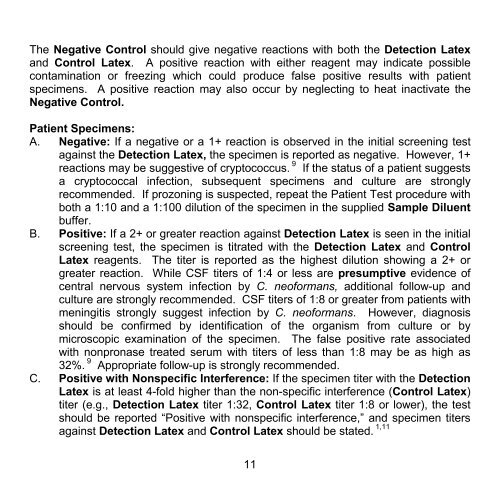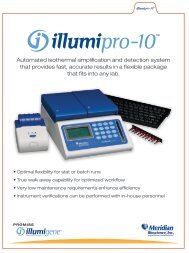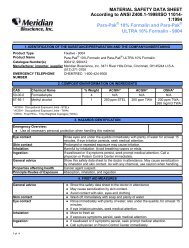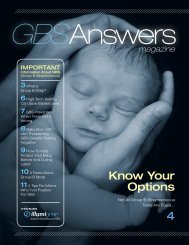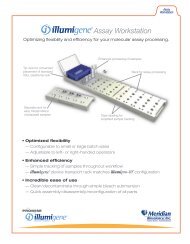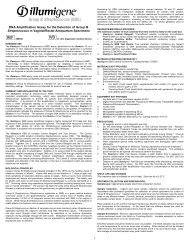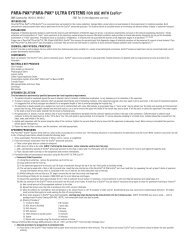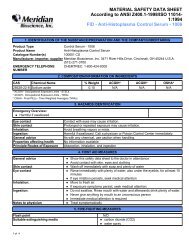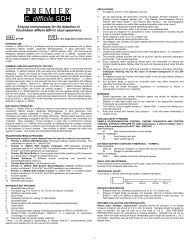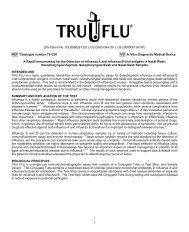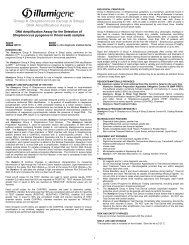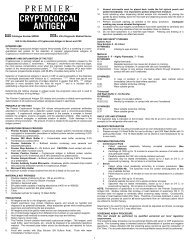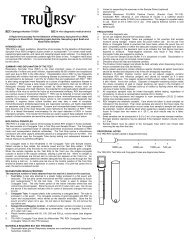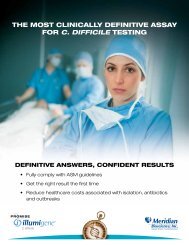Cryptococcal Antigen Latex Agglutination System (CALAS®)
Cryptococcal Antigen Latex Agglutination System (CALAS®)
Cryptococcal Antigen Latex Agglutination System (CALAS®)
You also want an ePaper? Increase the reach of your titles
YUMPU automatically turns print PDFs into web optimized ePapers that Google loves.
The Negative Control should give negative reactions with both the Detection <strong>Latex</strong><br />
and Control <strong>Latex</strong>. A positive reaction with either reagent may indicate possible<br />
contamination or freezing which could produce false positive results with patient<br />
specimens. A positive reaction may also occur by neglecting to heat inactivate the<br />
Negative Control.<br />
Patient Specimens:<br />
A. Negative: If a negative or a 1+ reaction is observed in the initial screening test<br />
against the Detection <strong>Latex</strong>, the specimen is reported as negative. However, 1+<br />
reactions may be suggestive of cryptococcus. 9 If the status of a patient suggests<br />
a cryptococcal infection, subsequent specimens and culture are strongly<br />
recommended. If prozoning is suspected, repeat the Patient Test procedure with<br />
both a 1:10 and a 1:100 dilution of the specimen in the supplied Sample Diluent<br />
buffer.<br />
B. Positive: If a 2+ or greater reaction against Detection <strong>Latex</strong> is seen in the initial<br />
screening test, the specimen is titrated with the Detection <strong>Latex</strong> and Control<br />
<strong>Latex</strong> reagents. The titer is reported as the highest dilution showing a 2+ or<br />
greater reaction. While CSF titers of 1:4 or less are presumptive evidence of<br />
central nervous system infection by C. neoformans, additional follow-up and<br />
culture are strongly recommended. CSF titers of 1:8 or greater from patients with<br />
meningitis strongly suggest infection by C. neoformans. However, diagnosis<br />
should be confirmed by identification of the organism from culture or by<br />
microscopic examination of the specimen. The false positive rate associated<br />
with nonpronase treated serum with titers of less than 1:8 may be as high as<br />
32%. 9 Appropriate follow-up is strongly recommended.<br />
C. Positive with Nonspecific Interference: If the specimen titer with the Detection<br />
<strong>Latex</strong> is at least 4-fold higher than the non-specific interference (Control <strong>Latex</strong>)<br />
titer (e.g., Detection <strong>Latex</strong> titer 1:32, Control <strong>Latex</strong> titer 1:8 or lower), the test<br />
should be reported “Positive with nonspecific interference,” and specimen titers<br />
against Detection <strong>Latex</strong> and Control <strong>Latex</strong> should be stated. 1,11<br />
11


